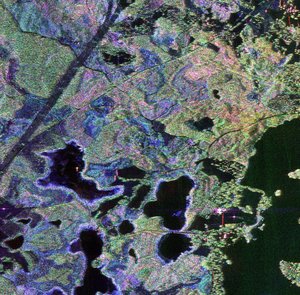Forests and climate
Through the burning of fossil fuels and deforestation, more and more carbon dioxide is being pumped into the atmosphere. Human activity has pushed atmospheric concentrations of carbon dioxide to almost 50% above the pre-industrial levels of 1850. Atmospheric carbon dioxide concentrations, as of February 2025, stand at 427 ppm compared to around 278 ppm in 1850.
As a potent greenhouse gas, carbon dioxide is a major driver of climate change and rising global temperatures. Alarmingly, recent data suggests that 2024 was the first year with a global mean temperature exceeding 1.5°C above the 1850–1900 average.
While the call to address climate change through the reduction of greenhouse gas emissions is high on the global agenda, much is still unknown about how carbon moves between Earth’s surface and atmosphere. Fundamental to understanding the global carbon cycle is accurate knowledge of how much carbon is stored in the atmosphere, ocean and terrestrial biosphere – the carbon stocks, and the rate of flow, or fluxes, between these stocks.
The burning of fossil fuel is estimated to account for around 90% of the additional carbon dioxide now in the atmosphere, the remainder has come from land-use change in the Tropics – mainly deforestation. However, there remains some mystery about the processes involved in the cycling of this carbon.

For example, the increase in concentrations of atmospheric carbon dioxide only accounts for about half of the emissions measured between 2014 and 2023 – therefore the other ‘missing’ half must flow back to Earth’s surface. Current estimates suggest that around 27% of these emissions are taken up by the oceans and 30% by the land and, but there are large uncertainties in these values, especially with respect to sources and sinks over land.
The uncertainty of the land-use flux, which describes forest loss, is 64% and the uncertainty of the land sink, which describes the absorption of carbon by forests, is 28%. This reflects uncertainty in both biomass losses and gains, underlining that the key change processes governing the terrestrial components of the global carbon cycle are not well understood.

As well as their importance in regulating the climate, forests are home to around 80% of biodiversity on land, offer watershed protection and prevent soil erosion, and over 1.6 billion people depend on forests for timber, food, fuel, jobs and shelter. In essence we all depend on forests in one way or the other.
Even given huge importance of forests to the health of our planet and to all its inhabitants, it has been calculated that, on average, more than 100 sq km of forest is lost every day.

With forest biomass representing a proxy for stored carbon, the Biomass mission is designed to measure forest biomass, height and disturbance to address gaps in our knowledge of the carbon cycle. The mission can deliver data with the resolution and accuracy needed for international reporting on carbon stocks and terrestrial carbon models. Biomass’ observations will also lead to better insight into rates of habitat loss, and the impact this may be having on biodiversity in the forest environment.
In addition, the mission can be used to map subsurface geology in deserts and to map the topography of forest floors.
Back to Biomass homepage |















 Germany
Germany
 Austria
Austria
 Belgium
Belgium
 Denmark
Denmark
 Spain
Spain
 Estonia
Estonia
 Finland
Finland
 France
France
 Greece
Greece
 Hungary
Hungary
 Ireland
Ireland
 Italy
Italy
 Luxembourg
Luxembourg
 Norway
Norway
 The Netherlands
The Netherlands
 Poland
Poland
 Portugal
Portugal
 Czechia
Czechia
 Romania
Romania
 United Kingdom
United Kingdom
 Slovenia
Slovenia
 Sweden
Sweden
 Switzerland
Switzerland





























